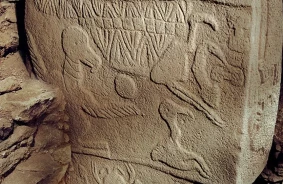Archaeologists have uncovered ancient burials and remnants of fortifications in the Tweeddale region of southern Scotland, which may validate local folklore regarding the grave of the legendary wizard Merlin.
Merlin, the fabled wizard from Arthurian legends, is renowned as a powerful sorcerer and wise mentor to King Arthur. According to tradition, he assisted Uther Pendragon, Arthur's father, and later educated Arthur himself. Merlin guided Arthur to the sword in the stone, which he successfully extracted, becoming king. As Arthur's chief advisor, he defended the kingdom with his magic and wisdom. There are various accounts of Merlin's demise: one states that he was imprisoned by the sorceress Nimue, while another suggests he was killed by his sister Morgana.
Historians believe that the legends of King Arthur gained prominence in Britain during the 12th and 13th centuries. One of the earliest sources of these tales was "The History of the Britons" by the Welsh chronicler Nennius, authored in the late 8th to early 9th century.
Recent archaeological excavations in the Tweeddale region have attracted the attention of scholars and history enthusiasts from around the globe. The GUARD Archaeology team focused their research around the ancient village of Drumelzier, long associated with the legends of Merlin.
Archaeologists examined the Tinnis fort, situated near the suspected burial site of Merlin. They determined that people inhabited the fort in the late 6th to early 7th century. This time period aligns with when the legend of Merlin is believed to have originated.
Scientists uncovered charred fortifications at the Tinnis site. This indicates that the structure was destroyed by a significant fire during the late Iron Age. It likely occurred amidst military conflicts between local rulers.
On the opposite side of the River Tweed, archaeologists investigated the Tirlstane barrows. Among their findings was a square barrow dating from the period between the late 3rd and late 6th centuries. It contained the remains of individuals of high social status, suggesting the importance of this site to the early Britons of the region.
Researchers conducted geophysical surveys in the area where Merlin's grave is said to be located. They discovered an object resembling a burial site at the base of one of the barrows. Interestingly, this aligns with Geoffrey of Monmouth's description of Merlin's grave: located at the base of an ancient tumulus overlooking the River Tweed.
Archaeologists found evidence of human activity from various historical periods. At the summit of Tinnis Hill, they uncovered numerous fragments of flint tools from the late Mesolithic to early Neolithic periods. These findings suggest that early humans inhabited the Tweed valley as far back as prehistoric times.
While it is impossible to definitively confirm whether the discovered burial belongs to the legendary mentor of King Arthur, the presence of such an object in a location tied to folklore indicates a possible historical foundation for the legend of Merlin.
Sources: Dark-age-digs, Ancient-origins, Wikipedia, Guard-archaeology














Comments (0)
There are no comments for now